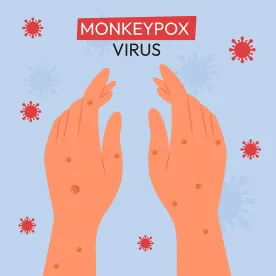On September 13, 2022, the California Division of Occupational Safety and Health (Cal/OSHA) issued guidance regarding protection of workers from monkeypox (MPX) under the Aerosol Transmissible Disease (ATD) Standard, California Code of Regulations, Title 8 Section 5199. Monkeypox is a viral infection that can spread from infected humans, animals, and materials contaminated with the virus. Cal/OSHA considers Monkeypox a new workplace hazard, so employers have a duty to protect their workers from the virus. Cal/OSHA’s monkeypox guidance does not discuss employers that are not covered by Section 5199. However, all employers, including those not covered under the ADT Standard may be required to address monkeypox-related hazards as workplace safety protections under the Injury and Illness Prevention Program (IIPP) required under Section 3203 and other Title 8 regulations.
The guidance provides the following information on monkeypox transmissibility and symptoms, and the preventive measures that covered California employers are required to take to protect their workers from monkeypox.
Monkeypox Transmission
According to the guidance:
[Monkeypox] spreads primarily by close or direct contact with infectious rashes, lesions, scabs, or body fluids. It can also spread through touching materials used by a person with MPX that haven’t been cleaned, such as clothing, towels, and bedding. The virus can become airborne during changing or handling of contaminated linen.
Symptoms
The guidance states:
Infection with MPX may start with symptoms similar to the flu, including fever, low energy, swollen lymph nodes, and general body aches, although some patients do not have these symptoms. After the fever starts, the person can develop a rash or lesions.
The guidance also states that an infection “typically lasts 2-4 weeks.”
Covered Employers
The guidance notes that the ATD standard has requirements that are specific to three different categories of employers, including “referring employers,” “laboratories,” and “all other employers.”
Referring employers
The guidance states that “[a] referring employer is an employer covered by the ATD Standard who refers airborne infectious disease cases and suspect cases, such as MPX, to other facilities.”
Laboratories
The guidance states that “[l]aboratory operations where employees may be exposed to certain aerosolized aerosol transmissible pathogens, including the MPX virus, are covered by the ATD Standard.”
“All other employers”
This category covers hospitals, homeless shelters, drug treatment programs, and correctional/detention facilities that are generally covered by the ATD standard.
Required Preventive Measures
The guidance states that all employers “must ensure that [personal protective equipment] is provided and used by employees exposed to persons with or suspected to have MPX, or to linens or surfaces that may contain the virus.” In addition, the guidance requires all employers to “implement written procedures for exposure incidents (also known as a ‘significant exposure’)” and report exposures to a local health officer.
The guidance requires hospitals and “all other employers” (and, in some cases, referring employers) to do the following:
-
“Implement a written [ATD] Exposure Control Plan specific to the workplace and operations.”
-
“Obtain the active involvement of employees in reviewing and updating the Exposure Control Plan.”
-
“Implement procedures to identify and isolate MPX cases and suspect cases. Transfer MPX cases and suspect cases to airborne infection isolation rooms or areas when possible and available.”
-
“[P]rovide and ensure [the] use of respiratory protection (fit-tested, NIOSH-approved particulate respirator equipped with an N95 filter or higher level of protection)” necessary to minimize employee exposure to MPX.
The guidance requires covered laboratories to “implement a written Biosafety Plan to minimize employee exposures to aerosol transmissible pathogens.” The guidance lists numerous criteria that written biosafety plans must meet to be in compliance with Cal/OSHA’s requirements.
Key Takeaways
California employers that are not covered by the ATD regulations may want to consider whether their employees are at risk for exposure to monkeypox, and if so, evaluate and address the hazard under their IIPP.





 />i
/>i

